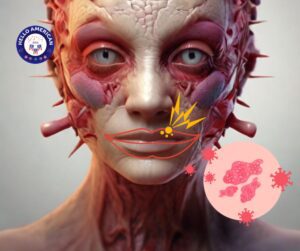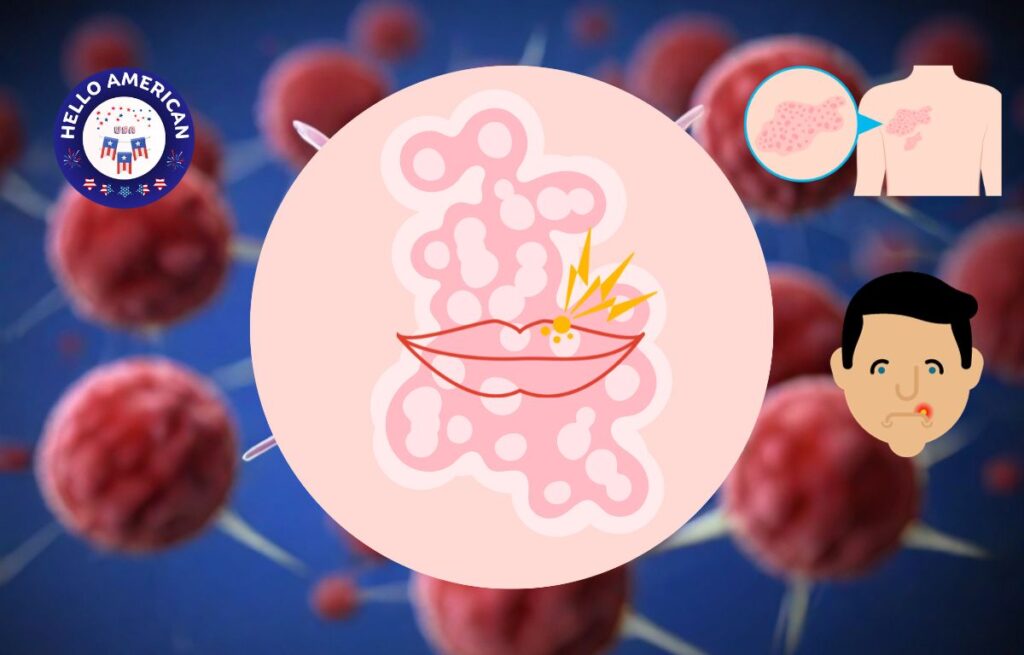Herpes simplex virus (HSV) is a common virus that exists in two types: HSV-1 and HSV-2. These viruses can cause oral and genital herpes infections.
HSV-1:
- Oral Herpes: Often associated with cold sores or fever blisters around the mouth or on the lips.
- Transmission: Primarily transmitted through oral-to-oral contact, typically during childhood via non-sexual contact.
- Symptoms: Cold sores, fever, swollen lymph nodes, and occasional painful mouth ulcers.
- Infection Site: Usually affects the mouth, lips, and facial area.
HSV-2:
- Genital Herpes: Commonly causes sores and blisters in the genital and anal areas.
- Transmission: Mainly transmitted through sexual contact, including vaginal, anal, or oral sex.
- Symptoms: Genital blisters, painful urination, itching, and flu-like symptoms.
- Infection Site: Primarily affects the genital and anal regions.
Transmission:
- Direct Contact: Spread occurs through contact with infected skin, mucous membranes, or bodily fluids (e.g., saliva, genital secretions).
- Asymptomatic Shedding: The virus can be transmitted even when no symptoms are present, making individuals contagious.
Diagnosis:
- Physical Examination: Healthcare providers visually inspect sores or lesions.
- Laboratory Tests: Swab samples from sores or blood tests (PCR or serological tests) can confirm HSV infection.
Treatment:
- Antiviral Medications: Drugs like acyclovir, valacyclovir, and famciclovir help manage symptoms, reduce outbreak duration and frequency, and lower transmission risk.
Recurrence:
- Latent Infection: After the initial infection, the virus remains in the body and can reactivate, leading to recurrent outbreaks.
- Trigger Factors: Stress, illness, hormonal changes, sunlight, and weakened immune system can trigger recurrences.
Complications:
- Neonatal Herpes: HSV transmission from mother to newborn during childbirth can cause severe complications in infants.
- Encephalitis: Rare but serious inflammation of the brain caused by HSV infection.
Prevention:
- Safe Practices: Use condoms during sexual activity to reduce the risk of transmission.
- Avoid Contact: Refrain from kissing or intimate contact during active outbreaks.
- Hygiene: Practice good hygiene to minimize the spread of the virus.
Research:
- Vaccines: Ongoing research aims to develop vaccines to prevent or reduce the severity of HSV infections, but no licensed vaccine is available yet.
While herpes infections are not curable, management strategies focus on symptom relief, reducing transmission risk, and improving individuals’ quality of life. Seeking medical advice and practicing preventive measures are crucial for managing herpes infections.


Overview of herpes simplex virus (HSV) from A to Z:
A – Asymptomatic Shedding:
HSV can be active and contagious even when no symptoms are present, leading to asymptomatic shedding where the virus is released from the skin without causing noticeable symptoms.
B – Blister or Cold Sore:
Herpes simplex virus often causes blister-like sores, commonly known as cold sores or fever blisters, around the mouth or genital area.
C – Cold Sores:
HSV-1 (usually associated with oral herpes) can cause cold sores, characterized by painful, fluid-filled blisters on or around the lips, mouth, or face.
D – Direct Contact:
HSV spreads through direct contact with infected skin or bodily fluids (such as saliva or genital secretions) during active outbreaks or asymptomatic shedding.
E – Encephalitis:
Rarely, HSV infection can lead to herpes simplex encephalitis, a severe brain infection that can cause inflammation of the brain and be life-threatening if not treated promptly.
F – Fever:
Initial herpes outbreaks might be accompanied by fever, body aches, swollen lymph nodes, and general malaise.
G – Genital Herpes:
HSV-2 is primarily associated with genital herpes, causing sores and blisters on or around the genital area.
H – Herpes Simplex Virus:
HSV is a DNA virus that exists in two types: HSV-1 (oral herpes) and HSV-2 (genital herpes). It is highly contagious and can cause recurring outbreaks.
I – Immunocompromised:
People with weakened immune systems, such as those with HIV/AIDS or undergoing immunosuppressive treatments, might experience more severe or frequent herpes outbreaks.
J – Joints and Muscles:
Herpes outbreaks can sometimes cause pain and discomfort in joints and muscles.
K – Kids and Neonates:
Newborns can contract herpes during childbirth if the mother has active genital herpes, which can lead to serious complications in infants.
L – Latency:
After the initial infection, HSV can establish a latent (dormant) phase in nerve cells and reactivate periodically, causing recurrent outbreaks.
M – Mucous Membranes:
HSV can infect mucous membranes of the mouth, genitals, and other areas, leading to the formation of sores.
N – Neuralgia:
Some individuals might experience neuropathic pain or neuralgia during or between herpes outbreaks.
O – Oral Sex:
HSV-1 or HSV-2 can be transmitted through oral sex, leading to oral or genital herpes depending on the virus type and site of contact.
P – Prodrome:
Before a herpes outbreak, some people might experience a prodrome—a warning period with symptoms like tingling, itching, or burning at the outbreak site.
Q – Quality of Life:
Recurrent herpes outbreaks can impact an individual’s quality of life due to physical discomfort, social stigma, and emotional distress associated with the condition.
R – Recurrence:
After the initial infection, herpes outbreaks can recur periodically, triggered by factors such as stress, illness, hormonal changes, or sun exposure.
S – Sexual Transmission:
HSV can be sexually transmitted through vaginal, anal, or oral sex, even when no visible symptoms are present.
T – Treatment:
Antiviral medications like acyclovir, valacyclovir, and famciclovir can help manage and reduce the frequency and severity of herpes outbreaks.
U – Ulcers:
Herpes sores can develop into painful ulcers before healing.
V – Vaccine Research:
Efforts are ongoing to develop vaccines against HSV to prevent or reduce the severity of herpes infections.
W – Wet Mount Test:
Laboratory tests, including viral culture or PCR tests, can diagnose herpes infections by detecting the presence of the virus in samples from sores or genital secretions.
X – Xeroform Dressing:
Topical treatments like xeroform dressings may be used to cover herpes sores and promote healing.
Y – Years of Infection:
HSV infections are lifelong, and while antiviral medications can manage outbreaks, the virus remains in the body indefinitely.
Z – Zero Cure:
Currently, there is no cure for herpes, but treatment can help manage symptoms and reduce the frequency of outbreaks.
This comprehensive overview covers various aspects of herpes simplex virus infections, from transmission and symptoms to management and impact on individuals’ lives. If you have any specific questions or need more information, feel free to ask!


